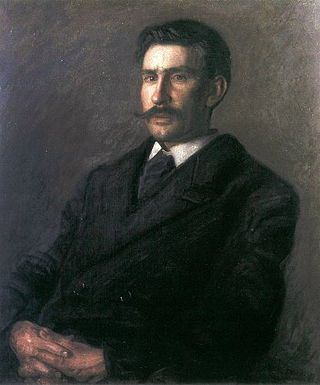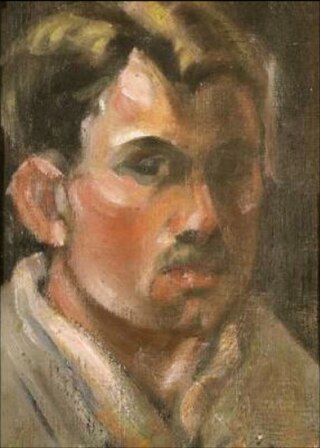
American Impressionism was a style of painting related to European Impressionism and practiced by American artists in the United States from the mid-nineteenth century through the beginning of the twentieth. The style is characterized by loose brushwork and vivid colors with a wide array of subject matters but focusing on landscapes and upper-class domestic life.

Maurice Brazil Prendergast was an American artist who painted in oil and watercolor, and created monotypes. His delicate landscapes and scenes of modern life, characterized by mosaic-like color, are generally associated with Post-Impressionism. Prendergast, however, was also a member of The Eight, a group of early twentieth-century American artists who, aside from Prendergast, represented the Ashcan School.

Frederick Childe Hassam was an American Impressionist painter, noted for his urban and coastal scenes. Along with Mary Cassatt and John Henry Twachtman, Hassam was instrumental in promulgating Impressionism to American collectors, dealers, and museums. He produced over 3,000 paintings, oils, watercolors, etchings, and lithographs over the course of his career, and was an influential American artist of the early 20th century.

The Ten American Painters was an artists' group formed in 1898 to exhibit their work as a unified group. John Henry Twachtman, J. Alden Weir, and Childe Hassam were the driving forces behind the organization. Dissatisfied with the conservatism of the American art establishment, the three artists recruited seven others from Boston, New York City, and elsewhere on the East Coast, with the intention of creating an exhibition society that valued their view of originality, imagination, and exhibition quality. The Ten achieved popular and critical success, and lasted two decades before dissolving.

The de Young Museum, formally the M. H. de Young Memorial Museum, is a fine arts museum located in San Francisco, California. Located in Golden Gate Park, it is a component of the Fine Arts Museums of San Francisco, along with the Legion of Honor. The de Young is named for early San Francisco newspaperman M. H. de Young.

Edward Willis Redfield was an American Impressionist landscape painter and member of the art colony at New Hope, Pennsylvania. He is best known today for his impressionist scenes of the New Hope area, often depicting the snow-covered countryside. He also spent his summers on Boothbay Harbor, Maine, where he interpreted the local coastline. He frequently painted Maine's Monhegan Island.

Xavier Timoteo Martínez was a Mexican-born American artist active in California the late 19th and early 20th century. He was a well-known bohemian figure in San Francisco, the East Bay, and the Monterey Peninsula and one of the co-founders of two California artists' organizations and an art gallery. He painted in a tonalist style and also produced monotypes, etchings, and silverpoint.

Euphemia Charlton Fortune (1885–1969) was an American Impressionist artist from California. She was trained in Europe, New York and San Francisco. She painted many portraits as well as landscape views of California and European sites. In midlife she turned to liturgical design. She signed her paintings "E. Charlton Fortune," which helped conceal her gender.

The Brauer Museum of Art was an art museum at Valparaiso University, a private university in Valparaiso, Indiana. It was home to a collection of 19th- and 20th-century American art, world religious art, and Midwestern regional art. It was located in the Valparaiso University Center for the Arts (VUCA). Prior to the museum's opening, the university's collection was housed and displayed within several buildings across campus. It was named the Brauer Museum of Art in 1996 to honor the collection's long-time director and curator, Richard H. W. Brauer. The university began exploring selling parts of its art collection in 2023, to significant controversy and adverse legal action, and closed the museum in the summer of 2024.

Soren Emil Carlsen was an American Impressionist painter who emigrated to the United States from Denmark. He became known for his still lifes. Later in his career, Carlsen expanded his range of subjects to include landscapes and seascapes as well.
Joseph Raphael (1869–1950) was an American Impressionist painter who spent most of his career as an expatriate but maintained close ties with the artistic community of San Francisco, California.

Colin Campbell Cooper, Jr. was an American impressionist painter of architectural paintings, especially of skyscrapers in New York City, Philadelphia, and Chicago. An avid traveler, he was also known for his paintings of European and Asian landmarks, as well as natural landscapes, portraits, florals, and interiors. In addition to being a painter, he was also a teacher and writer. His first wife, Emma Lampert Cooper, was also a highly regarded painter.

The terms California Impressionism and California Plein-Air Painting describe the large movement of 20th century artists who worked out of doors, directly from nature in California, United States. Their work became popular in the San Francisco Bay Area and Southern California in the first three decades after the turn of the 20th century. Considered to be a regional variation on American Impressionism, the California Impressionists are a subset of the California Plein-Air School.

Rinaldo Cuneo, was an American artist known for his landscape paintings and murals. He was dubbed "the Painter of San Francisco".

Gottardo Fidele Piazzoni was a Swiss-born American landscape painter, muralist and sculptor of Italian heritage, a key member of the school of Northern California artists in the early 1900s.

Cliff Rock - Appledore is an oil painting by American artist Childe Hassam, painted in 1903. It is part of the permanent collection at the Indianapolis Museum of Art.

Mary Evelyn McCormick was an American painter.

The Water Garden is a 1909 painting by the American Impressionist painter Childe Hassam. Done in oil on canvas, the painting is in the Metropolitan Museum of Art in New York.
In early 2023, Valparaiso University in Valparaiso, Indiana, U.S., under the leadership of president José Padilla, announced that it had decided to sell three paintings in its collection to fund dormitory renovations. The proposed sale of three paintings—Mountain Landscape by Frederic Edwin Church, The Silver Veil and the Golden Gate (1914) by Childe Hassam, and Rust Red Hills (1930) by Georgia O'Keeffe—sparked fierce opposition, including protests from faculty and students, and from Richard H. W. Brauer, founder and director of the university's Brauer Museum of Art where the paintings were exhibited.
The California series by Childe Hassam is a series of approximately 28 works based on American Impressionist Childe Hassam's visits to Northern California at least three times, in 1904, 1908, and 1914, and Southern California at least once in 1927. The works between 1904 and 1914 feature images from the San Francisco Bay Area, while the 1927-28 works feature images from Los Angeles, San Diego, and Santa Barbara. Out of his approximately 4000 works, Hassam's focus on California is relatively small, with only 12 major California paintings completed between 1914 and 1919. Additional minor works in the series include approximately 16 or so etchings from 1916 to 1928. Most of the works made in 1928 were based on drawings from 1927. 11 of the 12 California paintings were created in 1914 and first exhibited as part of the "California Group" of 106 paintings total in the Exhibition of Pictures by Childe Hassam at the Montross Gallery in New York in 1915. A twelfth painting in the series, California, has been dated to 1919. The majority of Hassam's Calfiornia etchings were first exhibited at the American Academy of Arts and Letters in 1927.





















